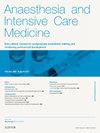General principles of paediatric anaesthesia
IF 0.3
Q4 ANESTHESIOLOGY
引用次数: 0
Abstract
Annually in the UK, around half a million children and infants undergo general anaesthesia. The provision of anaesthesia for this patient group can be a daunting task; the size of the patient is very variable, disease states and pathology are present that are not seen in other areas of practice, and there are substantial challenges of communicating and allaying anxiety. Additionally, unique medicolegal concepts exist. As those charged with the patients care during unique situations, it is important for anaesthetists to have a holistic understanding of the treatment they will be providing.
We have sought to consolidate the key areas of practice into core principles that can be applied to neonates, infants and children, to allow the reader insight into the foundations of safe paediatric anaesthetic conduct. Key important differences in these patient groups are outlined, including anatomy, drug handling and fluid requirements. Essential concepts of preoperative assessment and management of the anxious child are included, to provide colleagues with the tools for identification and management of challenging scenarios.
儿科麻醉的一般原则
在英国,每年大约有50万儿童和婴儿接受全身麻醉。为这一患者群体提供麻醉可能是一项艰巨的任务;患者的大小是非常多变的,疾病状态和病理是其他实践领域所没有的,并且在沟通和减轻焦虑方面存在重大挑战。此外,存在独特的医学法律概念。作为那些在特殊情况下负责病人护理的麻醉师,对他们将要提供的治疗有一个全面的了解是很重要的。我们力求将实践的关键领域整合为可应用于新生儿、婴儿和儿童的核心原则,以使读者深入了解安全儿科麻醉行为的基础。概述了这些患者群体的关键重要差异,包括解剖、药物处理和液体需求。包括焦虑儿童术前评估和管理的基本概念,为同事提供识别和管理挑战性情景的工具。
本文章由计算机程序翻译,如有差异,请以英文原文为准。
求助全文
约1分钟内获得全文
求助全文
来源期刊

Anaesthesia and Intensive Care Medicine
ANESTHESIOLOGY-
CiteScore
0.50
自引率
0.00%
发文量
152
期刊介绍:
Anaesthesia and Intensive Care Medicine, an invaluable source of up-to-date information, with the curriculum of both the Primary and Final FRCA examinations covered over a three-year cycle. Published monthly this ever-updating text book will be an invaluable source for both trainee and experienced anaesthetists. The enthusiastic editorial board, under the guidance of two eminent and experienced series editors, ensures Anaesthesia and Intensive Care Medicine covers all the key topics in a comprehensive and authoritative manner. Articles now include learning objectives and eash issue features MCQs, facilitating self-directed learning and enabling readers at all levels to test their knowledge. Each issue is divided between basic scientific and clinical sections. The basic science articles include anatomy, physiology, pharmacology, physics and clinical measurement, while the clinical sections cover anaesthetic agents and techniques, assessment and perioperative management. Further sections cover audit, trials, statistics, ethical and legal medicine, and the management of acute and chronic pain.
 求助内容:
求助内容: 应助结果提醒方式:
应助结果提醒方式:


